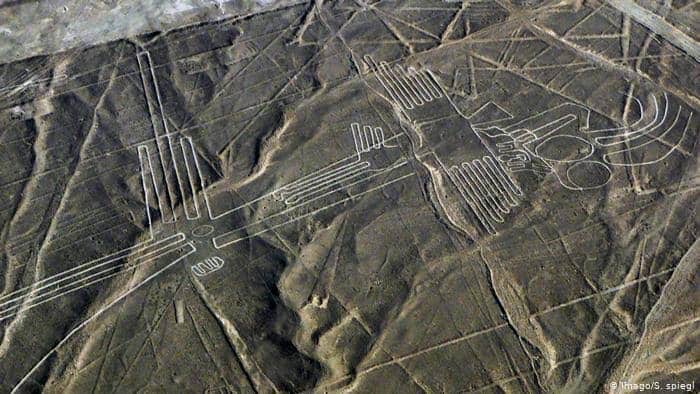
Nasca lines—subject of mystery for over 80 years. How were they formed? What purpose could they have served? Were aliens involved?
The lines are found in a region of Peru just over 200 miles southeast of Lima, near the modern town of Nasca. In total, there are over 800 straight lines, 300 geometric figures and 70 animal and plant designs, also called biomorphs. Some of the straight lines run up to 30 miles, while the biomorphs range from 50 to 1200 feet in length (as large as the Empire State Building).
The lines revealed
Peruvian archaeologist Toribio Mejia Xesspe was the first to systematically study the lines in 1926. However, since the lines are virtually impossible to identify from ground level, they were only first brought to public awareness with the advent of flight—by pilots flying commercial planes over Peru in the 1930s. American professor Paul Kosok investigated and found himself at the foot of a line on June 22, 1941—just one day after the winter solstice. At the end of a full day studying the lines, Kosok looked up from his work to catch the sunset in direct alignment with the line. Kosok called the 310 square mile stretch of high desert “the largest astronomy book in the world”.
Later, Kosok’s assistant, Maria Reiche, a German-born teacher and mathematician, found the same effect occurred on the summer solstice. She began to map the lines and discovered 18 different kinds of animals and birds. After Kosok left Peru in the 1940s, Reiche remained, dedicating her life to unravelling the mystery.
Her former home near Nazca, where she’s buried, is now a small museum, filled with her yellowing maps, blueprints, measuring tape and rolls of papers. There are photographs of her perched on top of a ladder in the middle of the desert, squinting in the bright sunlight to examine the lines; she even persuaded the Peruvian Air Force to help her make aerial photographic surveys.
Dubbed ‘the Lady of the Lines’, she also brought them to the world’s attention and played a vitally important role in their protection and conservation, educating both the public and the Peruvian government about their importance. She paid for private security to prevent them from further damage and convinced the government to limit access to the area. In 1994, four years before her death, the lines were finally declared a Unesco World Heritage Site – though not in time to save the Lizard, which was sliced in two by the Pan-American Highway.
Reiche believed the lines were built with sophisticated mathematical precision. However, in 1968 the English astronomer Gerald Hawkins effectively disproved her theory of astronomical alignment. He specialised in the field of archaeoastronomy and, using the same techniques he applied at Stonehenge, found that the lines he studied didn’t correspond to any celestial bodies.
The same year, perhaps the most implausible theory on the lines came from Swiss author, Erich von Daniken, who suggested in his book, Chariots of the Gods, that they were the runways of an ancient airfield used by extraterrestrial spacecraft. Other researchers believe that the lines are a precursor of the Inca ceques (sacred pathways) that radiate from Cusco, or a giant map pinpointing underground water supplies.
Because the lines are best seen from above, there are those who suspected that the Nazca were capable of flight long before Leonardo da Vinci sketched his flying machines. Pottery remains depict what could have been a kite or balloon, so enterprising researchers created a balloon out of materials that would have been available to the Nazca; after several attempts, it was airborne for less than 15 minutes.



